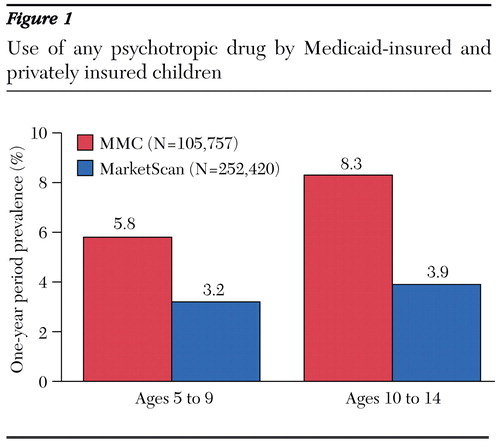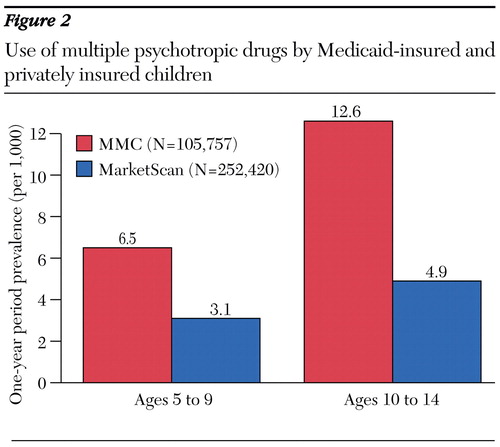Datapoints: Use of Multiple Psychotropic Drugs by Medicaid-Insured and Privately Insured Children
An increase in the prescription of combinations of psychotropic drugs to children has been documented in recent studies based on large nationally representative samples. This trend stands in sharp contrast with the paucity of empirical information to support this treatment pattern.
No published studies have addressed combination treatments. To that end, we analyzed 1999 data from two sources: the Medicaid Managed Care (MMC) database, maintained by the Connecticut Department of Social Services, and MEDSTAT's MarketScan database, which compiles nationwide claims information from private health insurance plans of large employers.
As depicted in Figure 1, the rate of psychotropic drug use was approximately double among the Medicaid-enrolled children. The higher prevalence in the older group is consistent with epidemiologic data and reflects the greater use of stimulants among school-age children. As shown in Figure 2, the rate of multiple psychotropic pharmacotherapy was also higher in the Medicaid population. (It should be noted that there is a tenfold difference in the vertical scale for the two figures.)
A larger proportion of Medicaid-enrolled children were given prescriptions for multiple psychotropics—even as fewer of them received outpatient mental health services. This finding suggests that they were treated more aggressively. The differences may be related to more severe psychopathology or psychosocial adversity; to variation in coverage for medications, copayment structure, or practice practices across treatment settings; or to other unmeasured plan-specific characteristics.
Dr. Martin Dr. Stubbe, Dr. Scahill, and Dr. Leslie are affiliated with the Yale University School of Medicine, 230 South Frontage Road, P.O. Box 207900, New Haven, Connecticut 06520-7900 (e-mail, [email protected]). Ms. Sherwin and Dr. Van Hoof are with Qualidigm in Middletown, Connecticut. Harold A. Pincus, M.D. and Terri L. Tanielian, M.A., are editors of this column.

Figure 1. Use of any psychotropic drug by Medicaid-insured and privately insured children

Figure 2. Use of multiple psychotropic drugs by Medicaid-insured and privately insured children



